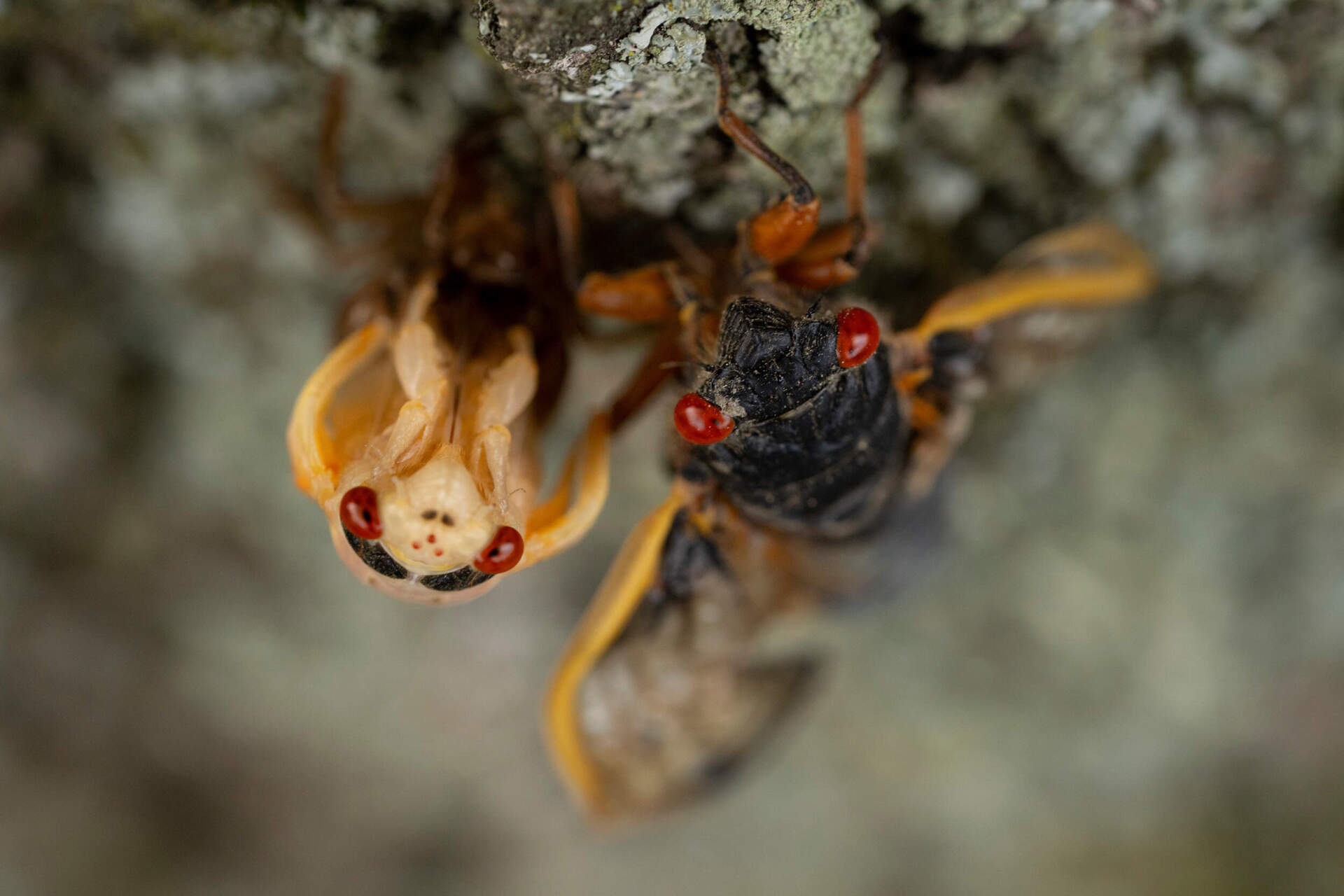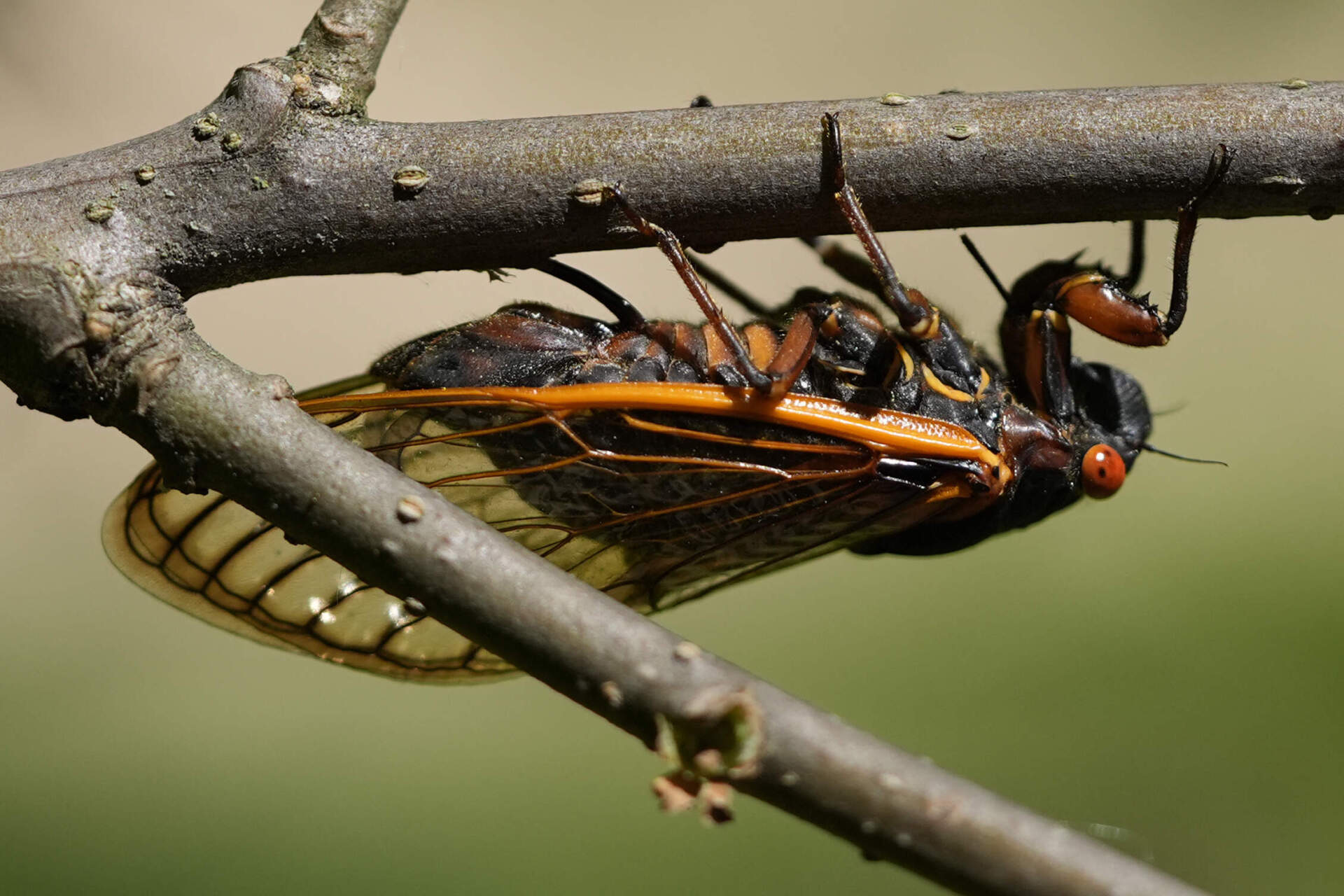Advertisement
After 17 years underground, periodical cicadas in Mass. crawl out this spring

The cicadas are coming.
After 17 years underground, a special variety of the insects, called periodical cicadas, will crawl up in parts of Massachusetts and across a broad swath of the country this spring. They're ready to shed their exoskeletons and put on a show.
The critters belong to Brood XIV, one of the largest posses of periodical cicadas by geographical span.
Beyond the Bay State, the bugs are predicted to pop out in parts of New York, New Jersey and Pennsylvania, all the way down to Tennessee and northern Georgia.
These periodical cicadas make far rarer appearances in Massachusetts than their relatives, the "dog day" cicadas, or "heat bugs." The loud songs of annual dog day cicadas make up a key part of the soundtrack to summer. As periodical cicadas add to the cacophony this year, you may notice they sound different, too.
"They make an odd pure toned call, so it's going to be kind of a whistling hum," said John Cooley, a professor and cicada researcher at the University of Connecticut.
Though technically quieter as individuals, periodical cicadas outnumber dog day cicadas. And when they sing in unison, their sounds build up to big noise.

Massachusetts residents won't hear them everywhere, however. Residents in parts of Barnstable and Plymouth counties stand the best odds.
Based on their last emergence in 2008, Cooley predicts they'll rise up from the dirt mostly near the canal and Upper Cape.
The cicadas will begin to emerge when soil temperatures roughly 8 inches below ground reach about 64 degrees, according to Tawny Simisky, a woody plant entomologist at the UMass Amherst extension program. That warmth will occur as early as mid-May, but likely later that month or in early June.
"In really dense areas where periodical cicadas exist, some estimate that you could have 1 million insects per acre," said Simisky. "Now that sounds like a very large, intimidating number, right? But if you think of how many ants you have per acre, you might not even notice those sorts of numbers."
Granted, she said, cicadas are larger than ants. Adult periodical cicadas measure about 1 to 2 inches long.
Advertisement
Their mass emergence is a species survival tool against predators, said Cooley.
"It's safety in numbers," he said. "And so you really don't find many kind of iffy or halfway emergences. They're always full on."
What happens when the cicadas rise up
All told, the cicadas will hang out above ground for about four to six weeks, according to Simisky. That's where they'll transition into adulthood and live out the rest of their mortal existence.
When cicadas tunnel up, they often create mud turrets as escape hatches, or mounds of soil surrounding penny-shaped holes. They emerge as immature insects and climb on trees — or things they mistake for trees — to molt.
They shed their exoskeletons, coming out as creamy-colored adult cicadas with new wings and red eyes. Their outer shell will harden and darken overtime. The blood red eyes stay.

Now adults, the cicadas go on a mission to mate. The female cicadas open up small slits on trees and shrubs and lay eggs inside. Each female can lay up to 600 eggs. Then, the adults die.
About six to 10 weeks after their eggs were laid, tiny nymphs will hatch and crawl down into the ground, where they will spend the next 17 years.
But life underground will still be active for the insects, says Simisky.
"All that time they're under there feeding on the roots of their host plants, they're surviving the winter," she said. "They're maintaining this synchrony with one another so that they know when all of the population is going to emerge in the next cycle, and hopefully surviving to do so."
Plant protection
Because cicadas lay their eggs by creating slits in plants, some trees or shrubs may experience what Cooley called "flagging," where the ends of branches die back.
Both Simisky and Cooley said that people generally do not need to take pest management measures against these native insects. They recommend wrapping any young ornamental or fruit trees in bird netting to prevent egg laying on fragile plants.
Native plants, like oaks, will be just fine, added Cooley, who notes the bugs' relationships with the tree species go back "millions of years."
And the dieback of some branches, Simisky said, can help plants thrive overall.
" Researchers have found that the egg laying by the adult female periodical cicadas can actually prune the trees and make our forests healthier," said Simisky.

What's special about the Massachusetts sect
Cooley said the Massachusetts contingent seem to be "a relic of a once much larger distribution" of cicadas in the area.
"The Massachusetts part of this brood is a bit of an oddity, as is the Long Island part, because they're going to occur in areas that are coastal and have sandy soil," said Cooley. "And that's typically not something that these cicadas like."
As a smaller portion of Brood XIV in a unique habitat, Cooley said he is concerned that the insects could be more vulnerable to dying off completely.
"This is one of the wonders of the world. And there really isn't anywhere else in the world you can see something like this."
John Cooley
"Once you push them below some threshold density, they're in trouble," said Cooley "And we have seen that on Long Island, the populations there have been just growing smaller and smaller over the past couple of generations."
Once they emerge, Cooley will work to collect data brood numbers.
UMass Extension, in collaboration with the Massachusetts Department of Agricultural Resources, is also gathering photos and reports from the public on when and where the cicadas emerge. Those insights can be used by scientists around the country to understand their activity, said Simisky.
While the entomologists acknowledge not everyone will be as excited to see them as they are, both Simisky and Cooley encourage people to try to enjoy this rare opportunity.
"This is one of the wonders of the world," said Cooley. "And there really isn't anywhere else in the world you can see something like this."
If you miss this emergence, you'll likely have another shot to see them. You'll just have to wait until 2042.
